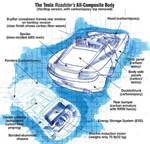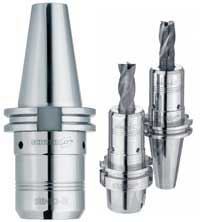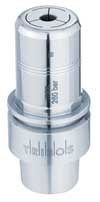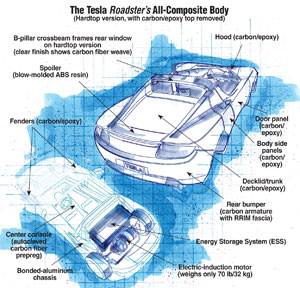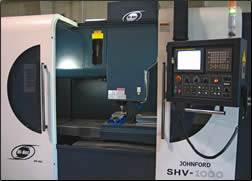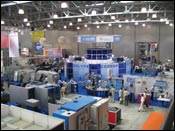How to Choose the Right Toolholder
The importance of choosing the optimum toolholder is substantial as the quality of the toolholder has a great influence on the results of the complete machining process.
Although it has minor importance with regard to value when compared to a complete machining center, the toolholder is an important connection between the machine spindle and the cutting tool. The importance in choosing the optimum toolholder is substantial as the quality of the toolholder has a great influence on the results of the complete machining process.
The most important requirements for a toolholder are the gripping force at high speeds as well as the run-out accuracy and balancing quality, which reduce vibrations. Toolholders need to have a run-out accuracy of less than 0.003 mm. To support the high dynamic of the linear actuation of the machine, a low weight of the spindle, toolholder and tool combination is beneficial to receive superior cutting results.
Customer requirements with regard to the cutting results of a toolholder are usually clearly defined and there are different types of toolholders available in the market that could fulfill these requirements.
Depending on the specific application of the customer, it will be possible to find the perfect toolholding system as the different systems offer different technical features and advantages. We will concentrate on the following four kinds of toolholders: (1) hydraulic toolholders, (2) toolholders for polygonal clamping, (3) universal toolholders and (4) heat shrinking holders.
Hydraulic Toolholders
Special toolholding solutions are applied for particular customer solutions. There is one toolholder that can be applied for most of the applications—a hydraulic toolholder (see Figure 1).
A hydraulic toolholder uses a different way of clamping the cutting tool compared to systems of conventional toolholders. Introduction of force is done via a screw (with a screw, a piston and sealing). By actuating (turning) the screw, an even hydraulic pressure is generated inside the toolholder. This pressure is transmitted via a steel expansion sleeve, which clamps the tool.
With this clamping system, best run-out accuracy and a repeatability of less than 0.003 mm (0.00012”) are achieved. As the cutting tool is held in a hydraulic chamber, the toolholder offers superior damping effects, due to the oil in the holder. The user gets a higher surface quality of the workpiece and higher up-times of the toolholder as small eruptions of material, as a result of vibrations of the cutter, are avoided.
These toolholders are not only maintenance-free and resistant against dirt, but they also are easy to use and offer a safe clamping of the cutting tool.
Toolholders for Polygonal Clamping
The polygonal clamping system (see Figure 2) is one of those highly engineered devices that is surprisingly simple: a ground polygon-shaped bore rigidly clamps a cutting tool in three places.
For high-speed applications, polygonal clamping is a great solution since the clamping of the tool shank is done by the elastic deformation of the holder. The main advantage of these toolholders is its extremely slim design.
There are two versions available on the market to cover different applications. A slim version of the toolholder, which stands out with its extremely slim design of the tool shank and its long reach of the tool. It is even possible to use shorter cutting tools with this holder, which in return, results in lower costs for the user. The rigid version of the toolholder has a bigger, and therefore, stiffer body of the holder and offers better qualities with regard to radial force compensation. Both versions can be used with long extensions, which make them even more flexible for difficult machining tasks.
Clamping of the tool or an extension is done within the elastic range of the material of the tool shank. Therefore, there are no restrictions with regard to the lifetime of the tool. Changing a tool can be done within seconds by using an external clamping device. This device does not need any external power source and therefore can be used anywhere. This fact makes polygonal clamping systems very interesting for applications that require a frequent tool change.
Universal Toolholders
The third toolholding system to be discussed are universal toolholders (see Figure 3). With two choices available—one for light-duty applications and one for medium- to heavy-duty applications—users have the possibility to gain the very important advantage of vibration damping for improved tool life and workpiece surface finish at a price point competitive with most high-end colleted toolholder systems.
These toolholders clamp tools using expansion technology similar to hydraulic toolholders, only the expansion is achieved via mechanical means instead of through a hydraulic fluid medium. This results in a toolholder system that provides the user with vibration damping and high runout accuracy—less than 0.005mm measured at the face of the toolholder.
Additional features of universal toolholders—when compared to colleted-style toolholder systems—are the ability to tighten the toolholders to a hard stop (no torque wrenches are required); a tight and secure clamping of the entire shank of the round tool (collets clamp more tightly near the nose of the toolholder and less tightly at the bottom of the clamping bore); flexible clamping through the use of standard intermediate sleeves; and, very accurate axial length adjustment through the use of an internal length adjustment screw.
Heat Shrinking Technology
The fourth toolholding system to note is heat shrinking technology (see Figure 4). This technology is based on heating up and cooling down a toolholder through induction technology.
An induction coil—with some units using a high frequency coil—heats up the toolholder precisely at the area where the tool has to be inserted. After inserting the cutting tool, you need to cool the toolholder, which can be done via a cooling jacket. Cooling down the toolholder will cause the holder to shrink around the cutting tool shank. In this way, the cutting tool is clamped and offers a force conclusive grip, which allows high torques.
The result of the shrinking process is an almost homogeneous tool with many advantages. Main benefits of the heat shrinking technology include high run-out accuracy of less than 0.003 mm, high transmissible torques and a relatively slim toolholder design. If it comes to vibration dampening, hydraulic toolholders or polygonal toolholders offer better qualities than heat shrinking toolholders.
Summary
What kind of toolholding system is the best? An answer to this question cannot be given generally as this depends on the particular application of the customer. When choosing the right toolholder, one basic requirement is that you know the static and dynamic characteristics of the toolholder. These characteristics have to be considered when examining the customer application and to be able to determine safe and effective machining parameters.
A comparison of the different tool-holders is very difficult, as they offer different benefits with regard to working principle, design and measures. A rating should only be done when considering the requirements of the particular application at the same time. A very rigid tool-holder is not appropriate for every application. A toolholder, which is perfectly suitable for high-speed machining, may not offer the needed values with regard to some other requirements.
Related Content
It Starts With the Part: A Plastic Part Checklist Ensures Good Mold Design
All successful mold build projects start with examining the part to be molded to ensure it is moldable and will meet the customers' production objectives.
Read MoreHow to Eliminate Chatter
Here are techniques commonly used to combat chatter and guidelines to establish a foundation for optimizing the moldmaking process.
Read MoreThe Ins and Outs of Hot Runner Temperature Control
A training checklist that explains the why and how of proper hot runner temperature control and system management.
Read MoreLaser Welding Versus Micro Welding
The latest battle in finely detailed restoration/repair of mold materials.
Read MoreRead Next
Accessorize Your Machine to Maximize Performance and Efficiency
Machine tool accessories offer economical solutions to many of the production and timing issues that can negatively impact tool and machine setup.
Read MoreHigh Speed Balancing Act
Think you’re using toolholders properly balanced for high-speed machining? Well, you may have to think again.
Read MoreSelecting the Best Toolholding Solution for Your Shop
A look at ER collet systems and a review of the properties to look for when making your toolholding purchase decision.
Read More
